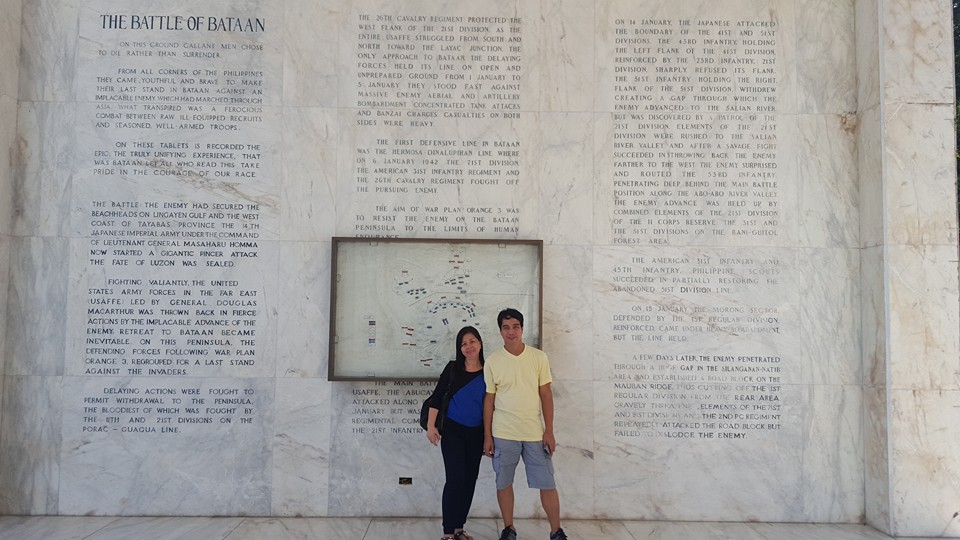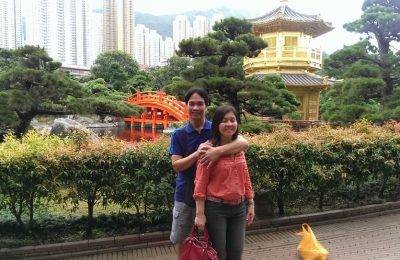Located in the heart of Bataan, Philippines, Mt. Samat is a historical site that serves as an honor and testament to Filipino’s courage. This is not just an ordinary mountain, it’s a historical place and a gateway to the natural beauty of my hometown, Pilar, in the Province of Bataan.
In my post about Las Casas Filipinas de Acuzar, I briefly mentioned Mt. Samat as another point of interest to visit while in Bataan. Well, guess what? I have been there with my family. This is the first time I climbed this mountain in years. The last time I can recall was back in college during physical education activities. The other one was when I was just a little boy during Araw ng Kagitingan or the Bataan Day celebration. I haven’t had a chance to revisit Mt. Samat since I moved in Metro Manila and started working, that’s why I am so happy to be able to go to this place again, much more happy because this time, I’m with my beloved family.

The Historic Mt. Samat (Pilar, Bataan)
During World War II, this site played a crucial role in the Battle of Bataan. The mountain served as a stronghold for Filipino and American forces defending against Japanese invasion. Today, it stands as a symbol of valor, commemorating the bravery of those who fought for freedom. At the summit, you’ll find the Dambana ng Kagitingan (Shrine of Valor), a towering 92-meter cross that dominates the skyline. This massive structure, visible from miles away, serves as a poignant reminder of the sacrifices made during the war. Inside the cross’s arms, an elevator takes visitors to an observation deck, offering panoramic views of Bataan Peninsula and beyond.

Even though I was born in Sampaloc, Manila, I spent and lived most of my life in Pilar, Bataan. Mt. Samat is a place that I see from a distance every single day. I remember our bedroom window had a good view of the cross and the shrine at the top of this mountain. I even used to check if there’s lights on top of Mt. Samat at night. I am very familiar with this mountain. Despite the closeness, I have been to the Dambana ng Kagitingan (Shrine of Valor) only a few times.
I finally had a chance to visit Mt. Samat with my family. This is a rare and special family bonding time for us. If you’re one of my family and you’re reading this, know that I love you so much. It may not show on a day to day basis, but I do. I will forever remember this day with you all.

How to Go to Mount Samat
Since we live in Pilar already and we’re just near Mt. Samat, we just rented a jeepney that will take us to the mountain’s peak. Yes, you don’t need to hike to get to the top. You can go there through any private vehicle or rent a van — or even a jeepney. Of course, you can also hike. I did once, and it’s a different experience altogether. Mt. Samat is a beautiful place, and you will encounter different views and secret paths that you will otherwise not experience if you climb it through vehicle. But we went there to bond and enjoy the shrine and the cross, so a jeepney to the top is enough.
If you’re from Metro Manila and you want to go to Mt. Samat, you may take a bus from Cubao, Pasay or Doroteo Jose (Bataan Transit/Genesis bus line) to Balanga City. The fare is around Php 300. Your travel time is 3 to 4 hours, depending on traffic condition. The buses usually will drop you off the Balanga Central Terminal. From the terminal, you can ride a jeepney going to Cabog-Cabog. If you’re not familiar with the place, please make sure to tell the driver to drop you off at the foot entrance of Mt. Samat or Dambana ng Kagitingan. Once you’re at the foot of the mountain, find the tricycles that can be rented to take you to the shrine at the top. Do not pay the driver of the tricycle until you’re back at the foot of the mountain so as to avoid being scammed.

The Mt. Samat’s shrine, also known as Shrine of Valor or Dambana ng Kagitingan in tagalog, is open daily from 8 a.m. to 5 p.m. The entrance fee is Php 20 regular, Php 10 for students and senior citizens, and Php 30 for foreigners and tourists. Parking fee is Php 30 for big vehicles and Php 20 for light vehicles. The fee to enter and go up the cross is Php 10. These are very affordable rates for the maintenance of such a beautiful and historic place.
When we entered the main entrance and paid the fees, our jeepney driver took us straight to the top where the cross is located. Now while this is just fine, I suggest you let your driver drop you off at the front of the shrine at the bottom and then let him park at the top near the cross. You can then start your way from the bottom to the top, where your ride is waiting for you. But since we’re already at the top, we decided to just start our tour there, take a rest and appreciate the sceneries. Mt. Samat is very beautiful! You have to be there at the top to really appreciate how natural and beautiful its beauty is. You have an amazing view of Bataan from atop. Seeing this paradise, I am just so proud to be from Bataan.


After eating snacks and having some “kulitan” moments, we then entered the giant cross. This is probably the highlight of the trip because once you’re at the top of the cross, you are in the highest area in the whole of the mountain or perhaps even Bataan. There’s a Php 10 fee to use the elevator. Only 6 people are allowed at a time. I remember back then they allow people to use the stairs to go up, but now due to its bad condition, for safety reasons, the stairs are off limits. I just love how when you’re inside the elevator, you have a small peek of what to see outside, and once the elevator door opens at the top…. wow… it’s a 360 degree aerial view of Bataan! It is breathtaking! There are huge windows open on each side where air can freely come in and out. I feel like we’re already in the clouds! A trip to Mt. Samat is worthy just for this experience right here at the top of the cross.




If you’re hungry and you didn’t bring any food with you, there’s a sari-sari store just at the back of the cross. The prices are a bit high than normal, but that’s to be expected. After enjoying our moment at the top of the cross, we then went down to the shrine. There’s a pathway that will lead you down. Once again, you will have a good view of the mountain and the surrounding areas. There’s a lot of trees that provide shade while walking down.


The best time to visit Mt. Samat is during the dry season, from November to May. This ensures clearer skies and more comfortable hiking conditions. However, if you’re up for a challenge and don’t mind occasional rain, the wet season (June to October) offers lush, green landscapes.
We then reached the Shrine of Valor. Its walls provide a good history of Bataan and the Death March. Please take some time to read it so you will appreciate more the events that transpired in Mt. Samat and Bataan, and why it’s so important in Philippines’ history. The marble floor and walls, plus the huge chandeliers that adorn the ceiling are beautiful.




We then went to the museum located below the shrine. Make sure you keep the ticket that they gave you at the entrance earlier because they will look for it when you enter the museum. The museum is a good place to learn more about the history of Bataan. Taking pictures is allowed as long as you don’t use flash. I personally enjoyed the pictures during World War II. It makes me feel happy to be born in this generation and thankful to the brave men and women who fought hard to be where I am right now.

Tips When You Visit
1. Arrive Early: Beat the crowds and the heat by starting your visit in the morning.
2. Take a Guide: Local guides offer valuable insights into the site’s history and hidden gems.
3. Respect the Site: Remember, this is a war memorial. Maintain a respectful demeanor, especially in solemn areas.
4. Capture the Moment: The views from Mt. Samat are Instagram-worthy, but don’t forget to put the camera down and soak in the experience.
5. Combine with Other Attractions: Consider visiting nearby sites like the Bataan Nuclear Power Plant or Las Casas Filipinas de Acuzar to make a full day trip.









Visiting Mt. Samat is more than just a trip to a historical site; it’s an immersive journey through Philippine history, natural beauty, and human resilience. From the awe-inspiring Dambana ng Kagitingan to the serene forest trails, every aspect of Mt. Samat tells a story of courage, sacrifice, and hope. Whether you’re seeking historical insights, breathtaking views, or a moment of reflection, Mt. Samat offers an experience that will stay with you long after you’ve descended from its heights. So pack your bags, lace up your shoes, and prepare for an adventure that blends the past with the present in the most spectacular way.






